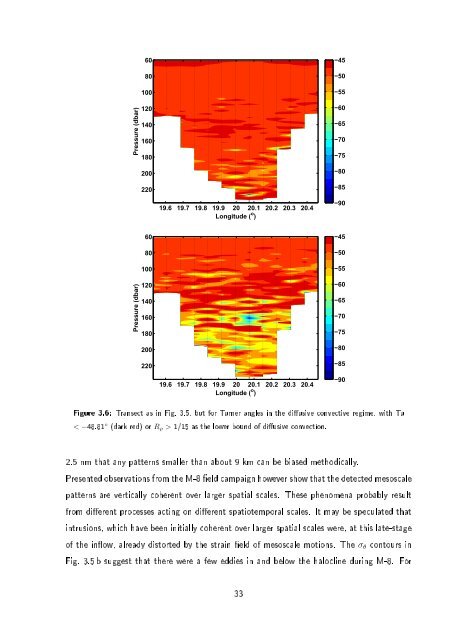Baltic Sea
Baltic Sea
Baltic Sea
Create successful ePaper yourself
Turn your PDF publications into a flip-book with our unique Google optimized e-Paper software.
60<br />
80<br />
100<br />
−45<br />
−50<br />
−55<br />
Pressure (dbar)<br />
120<br />
140<br />
160<br />
180<br />
−60<br />
−65<br />
−70<br />
−75<br />
200<br />
220<br />
−80<br />
−85<br />
19.6 19.7 19.8 19.9 20 20.1 20.2 20.3 20.4<br />
Longitude ( o )<br />
−90<br />
60<br />
80<br />
100<br />
−45<br />
−50<br />
−55<br />
Pressure (dbar)<br />
120<br />
140<br />
160<br />
180<br />
−60<br />
−65<br />
−70<br />
−75<br />
200<br />
220<br />
−80<br />
−85<br />
19.6 19.7 19.8 19.9 20 20.1 20.2 20.3 20.4<br />
Longitude ( o )<br />
−90<br />
Figure 3.6: Transect as in Fig. 3.5, but for Turner angles in the diusive convective regime, with Tu<br />
< −48.81 ◦ (dark red) or R ρ > 1/15 as the lower bound of diusive convection.<br />
2.5 nm that any patterns smaller than about 9 km can be biased methodically.<br />
Presented observations from the M-8 eld campaign however show that the detected mesoscale<br />
patterns are vertically coherent over larger spatial scales. These phenomena probably result<br />
from dierent processes acting on dierent spatiotemporal scales. It may be speculated that<br />
intrusions, which have been initially coherent over larger spatial scales were, at this late-stage<br />
of the inow, already distorted by the strain eld of mesoscale motions. The σ θ contours in<br />
Fig. 3.5 b suggest that there were a few eddies in and below the halocline during M-8. For<br />
33



